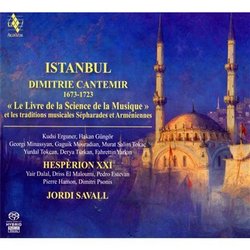A Turkic Homo Sapiens known as Cromagnon
Jacques COULARDEAU | OLLIERGUES France | 02/05/2010
(5 out of 5 stars)
"This recording is an essential step in the re-building of the common cultural stock that unifies our European and Mediterranean world. Apart from the fact that the first homo sapiens occupants (Cromagnon) of Europe were of Turkic culture and language (as shown in the most recent archaeological linguistic and cultural approaches of Europe), apart from the fact that in the old Nordic saga Sigurd (the ancestor of the Germanic Siegfried) we can find Attila the Hun, of Turkic language and culture, as the king of the European kingdom east of the old Burgundy and that Siegfried's widow is quite legitimate in her marrying him, thence transforming Attila's raids in the West as a re-conquering manoeuvre more than some barbaric looting adventures, the Ottoman Empire, in its golden age under Suleyman the Great was a harbour of peace and peaceful coexistence for the Ottoman Muslims, the Greek Orthodox Christians, the Sephardi tradition of the Jewish refugees from the Iberic Peninsula running away from the Catholic re-conquest, and the Armenian Christians. And this coexistence is most visible in the field of music. That's why this recording is essential even if Jordall decided not to separate the three main traditions, Moslem, Sephardi and Armenian. It makes the following of the various styles more difficult but it also gives us the feeling of a great tolerance that goes along with shifting from one tradition to the next without the slightest problem or conflict. French Ambassador Count Saint Priest said: "Most of the Great Sultan's musical retainers [...] who are the musical elite of the Turkish Empire, are of Greek, Jewish or Armenian origin". The first remark I will do on this music is about its rhythmic nature. According to Jordall it uses seven basic rhythmic patterns, when the European music of the time only mainly used two (6/4 and 2/4 and think of the bourrée and its ternary rhythm from Bach to Mozart and then Strauss). Among these seven rhythms there are two fast ones (14/4 and 16/4) and an extremely fast one (48/4). This has to be captured in perspective with the whirling dervishes of the Melveli order. Jordall's choice not to make all instruments play together all the time enables him to have many moments when one or two instruments can play solos or duos with a basic rhythm in the background produced by one or two drums. These instruments then can develop faster rhythms within the basic slow rhythm. This is a simple form of polyrhythmia (unimaginable in Europe at the time) and yet it is surprising since we consider that polyrhythmia is typically African and that it moved to America along with the black slaves of the slave trade to produce jazz, the blues, and all the vast cosmos of rock music, including with the invention of the specific "drums" this mostly amplified music uses, and this music then came back into Western music last century and is in the perspective of being globalized in this century. It is this polyrhythmic North American tradition of polyrhythmic questioning that has come back to Europe to inspire all kinds of contemporary styles and schools, from dodecaphonist to concrete and many others in between. This corresponds to the will to rediscover the body's (not to speak of society's) existential and organic rhythms that, thanks God, cannot be reduced to the sole heart beat and what's more seen as unchanging. We must thus think that polyrhythmia had left Africa along another path than the supposedly triangular slave trade, probably the Nile and then North Africa and the two Spanish-Portuguese and Arabic peninsulas to be integrated in the Moslem culture and then to expand to the Ottoman Empire. Jordall's choice to get liberated of the constant tuttis that some impose onto this music enables Jordall to really give us a serious capture of the instruments in their originalities and their particularities. The element of variation gives to that music one more dimension of multiplicity and variety. This recording hence is trying to give back to Istanbul the fundamental crossroads role it had just two or there centuries ago. All the more reason to discover this musical world.
Dr Jacques COULARDEAU, University of Paris 1 Pantheon Sorbonne, University Paris 8 Vincennes Saint Denis, University of Paris 12 Créteil, CEGID Boulogne Billancourt
"
Superb
JavaPro | United States | 01/11/2010
(5 out of 5 stars)
"Middle Eastern music that sounds authentic and, surprising to me, pleasant to my western ear. Similar in appeal to 'Nine Heavens' by Niyaz but more authentic in my opinion. Something you would want to play for friends at a party."
A class act
Aquinas | celestial heights, UK | 03/04/2010
(5 out of 5 stars)
"Anyone who has been to Istanbul, the great city between east and west with its mixture of Roman, Byzantine and Islamic architecture and art, should buy this album. Jordi Savall, who is famous for his early music and concept albums, has brought together the sefardic, armenian and turkish musical streams and it really is excellent. Take, for example, the second tune on the album which transmits huge amounts of energy. Buy this if you are interested in world music."


 Track Listings (21) - Disc #1
Track Listings (21) - Disc #1

